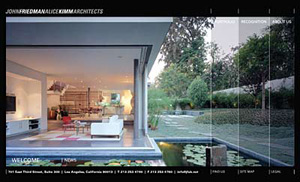If your firm isn’t called Gehry Partners, or Herzog & de Meuron, you probably believe in the importance of having a Web site that offers viewers an abundance of information about your company’s projects and services. Even though the American Institute of Architects’ newly published Firm Survey says that repeat business brings over half of the new work to architecture firms, it can only help to show the world who you are and what you do.

But, just as when architects design their own homes, the pressure is really on to put their best foot forward in creating a Web site. “We put a lot of thought into what we wanted our site to be,” says Joy Habian, director of communications for New York City–based Costas Kondylis and Partners Architects (kondylis.com). The firm hired communications company Blank Mosseri—which has designed sites for R.M. Kliment & Frances Halsbad Architects (kliment-halsband.com), Michael Graeff Architect (mgarchitect.com), and biproduct (biproduct.com)—to redesign its site in 2005. It opted for a design that would catalog its myriad projects—acting more as an overview and a resource for the media than an in-depth marketing tool. “We never intended the site to replace brochures,” says Habian, “but now those brochures can be more targeted to specific clients.”
Often firms use their sites to relay information about their design aesthetic and attract a particular kind of client. Alice Kimm, AIA, principal of 8-person firm John Friedman Alice Kimm Architects in Los Angeles (jfak.net), says, “The main purpose of the site is to gain a wider audience, and to ultimately recruit the “right” type of client—someone who understands a bit about us and can relate to our work. Many potential clients call us after having seen our Web site, which is great. People still like to see brochures, but we can direct people who don’t to our site.”
But David Skokna, creative director of Huge, a strategic design company that has designed sites for Hillier (hillier.com), DeStefano + Partners (dplusp.com), SmithGroup (smithgroup.com), and Beyer Blinder Bell (beyerblinderbelle.com), says that firm Web sites should be much more than project portfolios. “There are a lot of architecture firms out there,” he says, “and when potential clients see your site, you’ve got less than a minute to differentiate yourself from the crowd.” Huge’s director of client services Aaron Shapiro says, “Hillier’s story was that they had all these great experts working for the firm. We opted to open the site with pictures of people, and tell their story with surprising questions like ‘How can architecture help cure cancer?’ We then gave short explanations of why Hillier’s cancer-research buildings provided architectural solutions that led to more productive research. Anything you can do to catch people’s attention in simple, visual ways works best.”
Other firms organize their showcases by building type, have press releases, client testimonials, or even an internal, log-in area for multiple offices to communicate with each other. Gehry Partners’ site (foga.com) is almost entirely devoted to giving information about job openings, and can take applications on-line. But whatever the purpose, creativity, originality, and elegance always win over spectacle and extravagance.
The basics
As well as considering your budget, you have to consider that your site must continue to represent your firm into the foreseeable future. Updates must happen as work progresses, and you want to be able to keep the look, the feel, and the content continuous. Many firms opt to hire a pro. According to Myrna Davis, executive director of The Art Directors Club (adcglobal.org), one good way to start looking for the right designer is to look through recent Art Directors Annuals (The Art Directors Club, New York) for winners in the Web-site-design category, then review the winners’ sites. “Costs may range from the hundreds to hundreds of thousands of dollars,” says Davis, “depending on the client and the complexity, so I advise deciding on a budget and estimating the number of pages, images, and graphic designs that might be needed before seeking an estimate from a designer.” Other places to start include the AIGA, the professional association for design (aiga.org), or just researching the competition and calling to find out who designed favored sites.
A professional Web designer can help you automate your updates, giving you the tools to have a living, breathing site that is never out-of-date. According to Sidney Blank, principal at Blank Mosseri, a site can be set up dynamically with content-management tools so that the firm itself can continuously update its own content. While Habian and her team opted to have Blank Mosseri do the updating for kondylis.com every six months, other firms find that the do-it-yourself method works best. “Our in-house marketing team updates our site monthly,” says Kirsten Sibilia, Assoc. AIA, marketing director with New York City–based firm FXFowle Architects. “We don’t have to understand the technology of it, just the process. We decided it was worth it to pay extra to be able to accomplish simple updates in-house.” The 150-staff firm recently updated its site with the help of design communications firm Sundberg Associates. “Our site plays many roles for us,” says Sibilia. “Recruiting is crucial, so we wanted it to have cool and fun elements to attract young architects. We also wanted it to be low-tech enough to be navigable by anyone.”

Post a comment to this article
Report Abusive Comment